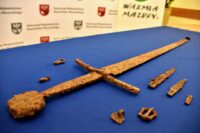 A sword and the metal parts of a scabbard, belt and two knives dating to the late 14th/early 15th century have been unearthed near the Olsztyn, northeastern Poland. Except for a coating of rust, the sword is in excellent condition. The exact location of the find is being kept secret to deter treasure hunters while an archaeologist prepare to excavate the find site.
A sword and the metal parts of a scabbard, belt and two knives dating to the late 14th/early 15th century have been unearthed near the Olsztyn, northeastern Poland. Except for a coating of rust, the sword is in excellent condition. The exact location of the find is being kept secret to deter treasure hunters while an archaeologist prepare to excavate the find site.
The sword was discovered by metal detectorist Aleksander Miedwiediew who found two 15th century battle axe heads last summer at a metal detector rally at the site of the Battle of Grunwald. He’s basically a medieval weapons magnet. He’s a very responsible one, thankfully, and he turned the sword set in to the Marshal of Warmia and Masuria.
It’s possible that this set too is related to the battle which took place near Stębark, less than 30 miles southwest of Olsztyn, on July 15th, 1410. More than 50,000 combatants, allied Polish and Lithuanian forces against the German Teutonic Knights, took the field there. It was one of the largest battles of medieval Europe and the Teutonic Knights were beaten so decisively that they lost their entire leadership to death or imprisonment. With an encounter of so enormous a scale, operations go beyond the boundaries of the battlefield, so the sword may have been lost in the maelstrom.
How exactly it could have been lost is a mystery. The sword was a very high-value item, the equivalent of a new car today, so it would not have been discarded.
“It’s puzzling that no one had taken hold of these items, very precious at the time. Maybe we will find the remains of a knight whom these things belonged to,” [director of the Battle of Grunwald Museum Szymon] Drej added.
 The sword and accessories have been transferred to the Battle of Grunwald Museum where they will be cleaned and conserved.
The sword and accessories have been transferred to the Battle of Grunwald Museum where they will be cleaned and conserved.
“The weapons will now undergo conservation and research process. We have a theory as to the sword’s medieval owner’s status, and we’re curious what’s underneath the layer of rust” – Drej added.
Now THAT is what I call a knife! :ohnoes:
It would be extremely interesting to see that sword in cleansed state: Sometimes there are marks, but I have frankly no idea what a “medieval owner’s status” would be here (I’d reckon, he is dead).
After travels to the Holy Land were no longer possible, organized adventure trips to savage Prussia, and what would be Lithuania, became fashionable allover Europe.
A letter written by John De Moulton of Frampton to his wife in 1367, confirms that “Anthony de Lucy and I and all our company make our way towards the parts of Prussia (…) along with Richard de Welby my companion.”
A professionally tinned body of a medieval man, however, was discovered at St. Bees Priory in 1981. His identity was subsequently established as that of Anthony de Lucy, 3rd Baron Lucy, obviously killed in 1368 on crusade at New Kaunas, fighting for the Teutonic Knights in the Northern Crusades (it seems that De Moulton died at New Kaunas also).
————–
youtube.com/watch?v=onrj4FGQDgw (autopsy)
youtube.com/watch?v=1pvNt354nNY (lecture)
youtube.com/watch?v=hJhCY__HwK0 (13th century music by Teutonic Knight Siboto III. “Tannhäuser”)
en.wikipedia.org/wiki/Tannhäuser
Also, a contemporary letter from 1411–1413, concerning fatal Lithuanian tactics of false retreats at Grunwald:
upload.wikimedia.org/wikipedia/commons/8/89/Anonymous_letter_concerning_the_Battle_of_Žalgiris_(Tannenberg).jpg
——
“…wann wenne eyn huffe addir eyne schigkunge tzutrauth wirt, so sintd die Iwthe nicht so rischlichen weddir umbe tzubrengen, wann denne eyn ydirman will yagen, unde waenth, das spil das sey gewunnen unde wissen nicht, das is halp mag seyn vorloren. Unde dorumbe so rothe wir euch, so wir getrwlichste kunnen, das ir die euwirn, so ir hogeste kunnet, mit eren schigkungen tzu haeffe haldet unde mit nichte von enandir losset, so lange bys das ir seet, wie sich euwir vinde huffe hindir dem fluchtigen an lesset. Unde dorumbe so bestellet das fleisseclichen mit euwirn gebitigern, das is veste gehalden werde, wann is kumpth wol das tzu angesichte in sotanem gescheffte, do XX addir dreysig yagen, das die machin, das undirwilen vil schigkunge gebrochin werden, do man wenth undirwilen ffromen tzu schaffen unde kumpth tzu grossem schaden.” :skull:
——